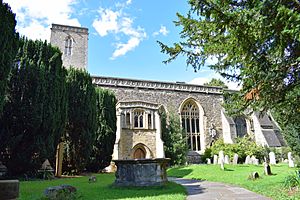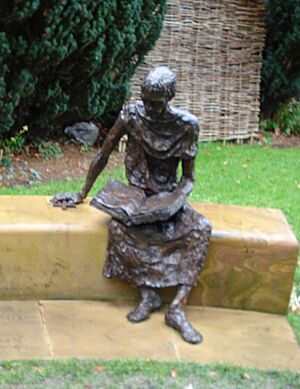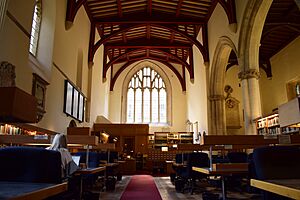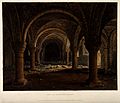St Peter-in-the-East facts for kids
Quick facts for kids St Peter-in-the-East |
|
|---|---|
| Parish Church of St Peter-in-the-East | |

St Peter-in-the-East, now St Edmund Hall library
|
|
| Location | Queen's Lane, Oxford |
| Country | United Kingdom |
| Denomination | Church of England |
| Website | St Edmund Hall Oxford |
| Architecture | |
| Style | Norman, Perpendicular Gothic |
| Years built | 12th century |
| Administration | |
| Diocese | Oxford |
St Peter-in-the-East is a very old church in Oxford, England. It was built in the 1100s, which is the 12th century! You can find it on Queen's Lane, near the High Street in the city center.
This church is no longer used for church services. Instead, it is now the library for St Edmund Hall, which is one of the colleges at the University of Oxford. Outside the church, there's a lovely garden. In the garden, you can see a bronze statue of St Edmund of Abingdon. It shows him as a student who didn't have much money.
Contents
History of the Church
A church has stood on this spot for a very long time. People believe there was a church here as early as the late 900s. In the 1000s, a new church made of stone was built. This church is even mentioned in the Domesday Book. The Domesday Book was a famous survey of England made around 1085 by William the Conqueror.
Why the Name "St Peter-in-the-East"?
The church is thought to be named after an old church in Rome, Italy. In the early 1100s, it got its full name, St Peter-in-the-East. This was to show its location near the East Gate of Oxford's old walled city. It helped people tell it apart from another church, the Church of St Peter-le-Bailey, which was near Oxford Castle.
Who Built the Church?
The parts of the church that look like Norman style were built around 1140. A man named Robert D'Oilly was in charge of Oxford at that time. He helped build these parts.
Later, in 1266, King Henry III gave the church to Walter de Merton. Because of this, Merton College became responsible for choosing the church's priest. This responsibility is called an advowson. Some other churches nearby, like those in Wolvercote and Holywell, started as smaller chapels connected to St Peter's. These were called chapels of ease.
Changes Over Time
In the 1900s, fewer people lived in central Oxford. This happened partly because of World War I. As a result, not many people attended the church anymore. So, in 1965, the church closed its doors.
The Church Today
In the 1970s, St Peter-in-the-East was changed from a church. This means it was deconsecrated, or no longer used for religious services. The building was then fixed up for its new purpose. Today, it is the college library for St Edmund Hall.
The Church Building's Design
The church built in the 1100s had three main parts: a crypt (an underground room), a chancel (the area around the altar), and a nave (the main part where people sit).
Later Additions
- In the 1200s, a north aisle was added to the nave. An aisle is a walkway along the side of the church.
- The church tower was built in the 1300s. The nave was also made taller or rebuilt to connect with this new tower.
- Most of the windows you see are from the 1300s. The door leading into the tower was added in the 1500s.
- At the east end of the aisle, there is a small chapel. It was built in the early 1500s and is dedicated to St Catharine and St Thomas.

The Lady Chapel
The Lady Chapel, also known as the North Chapel, was built in the early 1200s. It was given by Edmund Rich. He later became the Archbishop of Canterbury. He lived in the hall that was later named St Edmund Hall after him.
The north window in this chapel is from 1433. It was given by the vicar, Vincent Wyking. This window still has some original glass from that time, and even some older glass from the 1300s. The two east windows are called lancets. They are tall, narrow windows from the 1200s.
Images for kids








